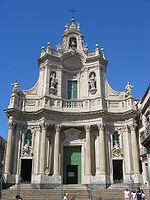
Basilica della Collegiata
Encyclopedia

Catania
Catania is an Italian city on the east coast of Sicily facing the Ionian Sea, between Messina and Syracuse. It is the capital of the homonymous province, and with 298,957 inhabitants it is the second-largest city in Sicily and the tenth in Italy.Catania is known to have a seismic history and...
, Sicily
Sicily
Sicily is a region of Italy, and is the largest island in the Mediterranean Sea. Along with the surrounding minor islands, it constitutes an autonomous region of Italy, the Regione Autonoma Siciliana Sicily has a rich and unique culture, especially with regard to the arts, music, literature,...
, southern Italy
Italy
Italy , officially the Italian Republic languages]] under the European Charter for Regional or Minority Languages. In each of these, Italy's official name is as follows:;;;;;;;;), is a unitary parliamentary republic in South-Central Europe. To the north it borders France, Switzerland, Austria and...
. Finished n 1768, it is an example of Sicilian Baroque
Sicilian Baroque
Sicilian Baroque is the distinctive form of Baroque architecture that took hold on the island of Sicily, off the southern coast of Italy, in the 17th and 18th centuries...
.
The church was built in the early 18th century, after the earthquake of 1693
1693 Sicily earthquake
The 1693 Sicily earthquake refers to a powerful earthquake that struck parts of southern Italy, notably Sicily, Calabria and Malta on January 11, 1693 around 9 pm local time. This earthquake was preceded by a damaging foreshock on January 9th...
that had destroyed most of the city.
Architecture
The design of the church is attributed to Angelo Italia, who changed the orientation of the previous edifice destroyed by the earthquake, in order to have it facing the new via Uzeda (current Etnea Street) according to the rebuilding plan of the city. The façade, designed by Stefano IttarStefano Ittar
Stefano Ittar was a Polish-Italian architect.-Biography:Ittar was born in Ovruch , where his father, a member of one of Italy's aristocratic families the Guidone de Hittar, had fled following a disagreement with the Grand Duke of Tuscany.While Ittar was still young his family moved to Rome, where...
, is one of the most notable examples of Sicilian Baroque
Sicilian Baroque
Sicilian Baroque is the distinctive form of Baroque architecture that took hold on the island of Sicily, off the southern coast of Italy, in the 17th and 18th centuries...
in Catania.
It has two orders, the first of which featuring six stone columns, surmounted by a balaustrade. The second order has a large central window, with, at the sides, four large statues of St. Peter, St. Paul, St. Agatha and St. Apollonia. Over the second floor is a central element housing the bells.
The church is accessed through a large staircase on which, delimiting the parvise
Parvise
Parvise or parvis may refer to:#A room over the porch of a church — quite often found in Norman churches in England. In some churches these rooms were used for school rooms and in Castle Ashby was the home of a woman - who saved the manor house from burning when she saw the fire taking hold from...
, is a wrought iron parapet.
Interior
Interior is on the basilica plan, with a nave and two aisles divided by two pilasters, and three apses. The central apse is rather elongated to house of the rectoryRectory
A rectory is the residence, or former residence, of a rector, most often a Christian cleric, but in some cases an academic rector or other person with that title...
.
The right aisle is home to a baptistery and three altars with canvasses of saints. At the end of the aisles is the Immaculate altar, preceded by a marble balaustrade, over which is a marble statue of the Madonna. In the apse of the nave is the high altar, with an icon of the Virgin with a Child, a copy of a Byzantine original in the sanctuary of Biancavilla
Biancavilla
Biancavilla is a town and comune in the Province of Catania, Sicily, southern Italy. It is located between the towns of Adrano and S. Maria di Licodia, 32 kilometers northwest of Catania.The town was founded on 8 January 1488 by Albanian refugees...
. Behind the altar are a 18th century wooden organ and a wooden choir.
The left aisle, in the apse area, houses the Holy Sacrament Chapel, with a marble altar. The vaults and the dome were frescoed in 1896 by Giuseppe Sciuti with scenes of the Life of Mary, Angels and Saints.

